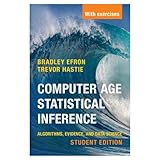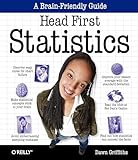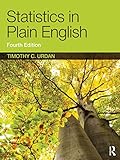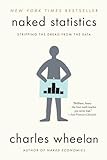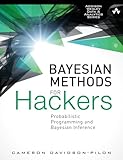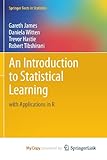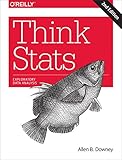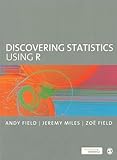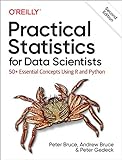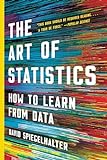Top 10 Best Data Science Statistics Books
Statistics is the study of different scenarios based on values and figures. It is collecting, categorizing, analyzing, interpreting, and determining a result from a given or obtained data set to arrive at a reasonable response. It has a wide scope and applications in different fields, including science, sports, medicines, business, etc. data science statistics is readily used in Python programming, machine learning, AI, and data analysis. There are several good books written on the subject; some of them are as follows –
- Computer Age Statistical Inference: Algorithms, Evidence, And Data Science ( Get this book )
- Head First Statistics: A Brain-Friendly Guide ( Get this book )
- Statistics In Plain English ( Get this book )
- Naked Statistics: Stripping The Dread From The Data ( Get this book )
- Bayesian Methods For Hackers: Probabilistic Programming And Bayesian Inference ( Get this book )
- An Introduction To Statistical Learning: With Applications In R ( Get this book )
- Think Stats: Exploratory Data Analysis ( Get this book )
- Discovering Statistics Using R ( Get this book )
- Practical Statistics For Data Scientists: 50+ Essential Concepts Using R And Python ( Get this book )
- The Art Of Statistics: How To Learn From Data ( Get this book )
Let us go through each book under the data science statistics books list with a small brief to understand and note some of the key aspects of them –
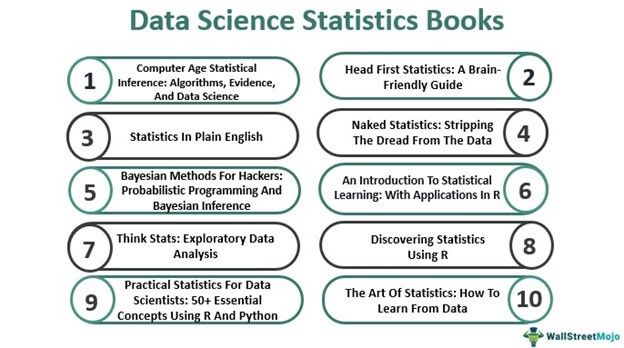
#1 – Computer Age Statistical Inference
Algorithms, Evidence, And Data Science
By Bradley Efron and Trevor Hastie
The book was released in 2016 and beautifully sheds light on data science and algorithms testing with context to statistical reference and calculations. It is one of the best data science statistics books for people looking to expand their knowledge.
Book Review
The book starts with classical inferential theories and talks about the revolution of data analysis and the period when electronic computation was introduced in the 1950s. It ends with future direction speculation in data science and statistics. It also stresses that terms like machine learning and big data are getting more popular daily.
Key Takeaways
- The book encompasses many theories like Bayesian, Fisherian, frequentist, etc.
- It has separate chapters on survival analysis, empirical Bayes, bootstrap, jackknife, etc.
- The authors used a modern approach that integrates methodology and algorithms in data science.
#2 – Head First Statistics: A Brain-Friendly Guide
By Dawn Griffiths
The book was released in 2005, and since then, it has provided its unquestionable contribution to statistics, mathematical calculations, and data analysis.
Book Review
Head First Statistics is the book that compiles all there is to know about statistics and calculations. It serves as an exhaustive guide for high school and college students and teaches everything there is to know about statistics. The book has many real-world examples to make it easy for a new reader to comprehend. In addition, the author shares equal knowledge on each topic, from the mean, median, and mode to probability and expectation.
Key Takeaways
- The book contains puzzles, quizzes, exercises, stories, and thought-provoking material for readers.
- It covers a full range of topics within first-year statistics.
- From students to professionals, anyone can have this book by their side with the urge to learn more about statistics.
- The book, if read thoroughly, can make people masters in statistics.
#3 – Statistics In Plain English
By Timothy C. Urdan
The book was published in 2001, gave conversational knowledge about statistics, and is straightforward to read.
Book Review
Every chapter in the book starts with an overview of the topic it focuses on and then steadily dives into a step-by-step understanding of its deep and advanced level of applications and functions. The author briefly explains when and where to use statistics, its benefits, and its limitations. Each chapter also includes a solid example to explain its working context to real-world research. It is helpful for a wide range of readers, enabling them to understand it in their way.
Key Takeaways
- The book features many real-world examples and explains many in-depth statistical techniques.
- For people who have left the subject long ago, the book can help them refresh their memory.
- It covers every topic from descriptive statistics to factor analysis and person-centered analyses, including assumptions used in statistics and the consequences of violating the regression assumptions.
#4 – Naked Statistics
Stripping The Dread From The Data
By Charles Wheelan
The book came out in 2012 and is written by the best-selling author of “Naked Economics,” who takes statistics and unravels them slowly and steadily for his readers and followers.
Book Review
The author firmly believes that statistics is evolving and point out several incidents worldwide about how students cheat in exams. How does the Netflix algorithm work, and what is causing the rising incidence of autism? The book suggests well-chosen statistical tools and the proper use of data. The book is a life-saver and in detail teaches real-world statistical applications. Finally, the author talks about data exploitation.
Key Takeaways
- The book discusses key concepts of inference, regression analysis, and correlation.
- The author explains the misrepresented data and data manipulation.
- He brings yet another statistical discipline into life by introducing this book.
- It is one of the best data science statistics books to read for people who want to explore the possibilities of statistics.
#5 – Bayesian Methods For Hackers
Probabilistic Programming And Bayesian Inference
By Cameron Davidson-Pilon
The book was first published in 2015 and focused on Bayesian interference as a powerful tool and complex analysis.
Book Review
The book revolves around Bayesian interference and probabilistic programming, closely related to Python tools. The author suggests that using the right approach can reach effective solutions in little progress without much mathematical intervention. People working on the PyMC code need this book as a guide they must carry for themselves. A focused reader will also learn the Markov Chain Monte Carlo algorithm, choose the right sample sizes, and work with loss functions.
Key Takeaways
- The book explains the computers performing Bayesian inference, their state of mind, and their implications.
- It helps in mastering concepts like clustering, autocorrelation, and thriving.
- It also helps understand the loss functions and how to measure the weakness.
#6 – An Introduction To Statistical Learning
With Applications In R
By Gareth James, Daniela Witten, Trevor Hastie, and Robert Tibshirani
The book was released in 2013 and offered an extensive overview of statistics and R applications, large data sets, and the wide scope of statistics.
Book Review
The book accounts for the best data modeling and prediction techniques with its applications. In addition, it shows the reader how vast the scope of work and use ranges from biology to finance and astrophysics. The book’s main ambition is to introduce and validate statistical earning techniques in fields lie science.
Key Takeaways
- The book covers re-sampling methods, support vector machines, linear regression, classification, shrinkage approaches, tree-based, and clustering.
- Each chapter includes a tutorial for methods presented by R to help readers grasp the content readily.
- The book gives no information on matrix algebra and prominently focuses on linear regression.
#7 – Think Stats: Exploratory Data Analysis
By Allen B. Downey
The book first came out in 2014 and brought out a case study for readers to work on as they move forward in this book.
Book Review
The book generally talks to people who write programs and turn data into knowledge. It directs towards using statistics and how to perform statistical analysis through computation with programs created in Python. The author explains how to identify patterns and test hypotheses. The book also shows how to run tests to check on statistical behaviors. It even has simulations for concepts that are hard to understand mathematically.
Key Takeaways
- The book dictates the rules of probability and visualization.
- It helps in developing code by writing and testing.
- It also goes into unchartered territories to cover topics not usually discussed.
- The author provides real-world data to work and practice data analysis.
#8 – Discovering Statistics Using R
By Andy Field, Jeremy Miles, and Zoe Field
The book was first released in 2012. Contrary to how popular and well-standardized writing is, it is written in a humorous and self-deprecating style that matches the way students like to read the book further.
Book Review
The authors make their readers fall in love with this book with its unique style of writing and point of view. It has a whole different perspective on the same concepts and terms. It takes students on a journey of statistical analysis and usage of R. It is becoming particularly popular across behavioral and social behaviors. The book starts with the basics and gives a guided tour of advanced-level learning.
Key Takeaways
- The book has some solid real-world examples of taking references from and consolidating knowledge.
- It offers many self-assessment tests and website material.
- The book is written humorously and not in a jargon style of writing.
- The authors talk about exploring and graphical representation of the data.
#9 – Practical Statistics For Data Scientists
50+ Essential Concepts Using R And Python
By Andrew Bruce, Peter C. Bruce, and Peter Gedeck
The book was originally published in 2017 and offers a different exposure to the applications of R and Python programming skills.
Book Review
The authors believe that many data science resources often lack in-depth perspectives on statistical analysis. To solve this issue, the readers and analysts must first learn its importance, scope, and to what extent it can be used. The authors in this book also point out data misuse and how to avoid it while performing analysis. Finally, the book reconnects the dots and refreshes the memory of a new reader in an accessible format.
Key Takeaways
- The book depicts the exploratory analysis of data and its importance.
- It covers regression, data extraction, machine learning, unlabeled data, and R and Python programming basics.
- The authors highlight the correct process of taking samples and yielding a higher dataset quality.
- They give 50+ concepts of R and Python.
#10 – The Art Of Statistics
How To Learn From Data
By David Spiegelhalter
The book came out in 2019 and is an essential and comprehensive guide to statistics and data science.
Book Review
The author states that statistics are everywhere. Not only does it have its applications in science but business as well. The author shows the readers how statistics determine the luckiest passenger on Titanic, how a serial killer could have been caught earlier, and many benefits of cancers. Yes, all such computation is only done using the right statistics and data. It is undoubtedly one of the best data science statistics books for young learners.
Key Takeaways
- The book talks about the art of statistics.
- It draws many real-world examples for readers to easily understand the acute effects of statistics.
- The author encourages people to think like statistical experts.
- He teaches how to understand the values obtained and take them in answer.
